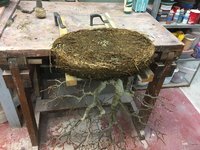Mike Corazzi
Masterpiece
I always have. Theory being that if ANYTHING decomposes, plugs up, goes bad,.......SOME water will make it to
a layer of coarse non organic chunks and migrate ....sideways if necessary.... and at least the bottom will get wet.
Judging from how roots will escape a pot for water, there's a good chance they will find a drainage layer to sneak into.
Maybe.
Correct me if you disagree.
a layer of coarse non organic chunks and migrate ....sideways if necessary.... and at least the bottom will get wet.
Judging from how roots will escape a pot for water, there's a good chance they will find a drainage layer to sneak into.
Maybe.
Correct me if you disagree.

